Table of Contents
What is Channel Control?
Channel Control is the ability of the manufacturer to influence the behavior of channel intermediaries. It includes foreseeing actions that help to check the intermediaries’ actions and performance so that the mutual goals of the two organizations can be achieved in a desired manner.
This can be exercised through effective leadership, exercising power, evaluating channel performance, managing channel conflict, and with a proper information system.
Channel Leadership and Power
Channels usually perform better if a party is in charge, providing some level of leadership. Essentially, the purpose of this leadership is to coordinate the goals and efforts of channel institutions. The level of leadership can range from very passive to quite active.
The style may range from very negative, based on fear and punishment, to very positive, based on encouragement and reward. In a given situation, any of these leadership styles may prove effective. Power is our willingness to use force in a relationship.
It is often the means by which we are able to control or influence the behavior of another party. In the channel mechanism, power refers to the capacity of a particular channel member to control or influence the behavior of another channel member.
For instance, a large retailer may want the manufacturer to modify the design of the product, or perhaps be required to carry fewer inventories. Both parties may attempt to exert their power in an attempt to influence the other’s behavior. The ability of either of the parties to achieve this outcome will depend upon the amount of power that each can bring.
Effective channel management can be achieved if channel members appoint effective leaders who take a broad inter-organizational perspective of distribution opportunities and problems. These leaders must emphasize the need to develop cordial channel relationships.
Channel leaders can use their leadership power to manage and resolve conflicts effectively, leading to improvement in the coordination and functioning of channels. The effectiveness of channel leaders depends on the extent of power they hold and the acceptance and attitude of the rest of the channel members.
Channel leaders must seek to reduce functional conflict and levels of dysfunction conflict in the channel. Channel leaders can use different methods to resolve channel conflicts. They include coercion, rewards, and the use of legitimate expert and referent power:

Reward Power
Reward power is the ability to offer a reward. Channel leaders can use reward power to resolve channel conflicts.
Coercive Power
Coercive power is a threat of punishment. The channel leader can use coercive power to control the actions of channel members. For example, a manufacturer might threaten a retailer with loss of exclusive distribution if it does not agree to do the desired tasks.
Legitimate Power
Legitimate power is power from contract agreements or organizational relationships. Channel leaders can reduce conflicts by using this power, which gives them the right to make certain decisions and ensure that other channel members follow them.
Expert Power
Expert power is power resulting from technological expertise or proprietary reasons. Expert power can be in the form of knowledge about certain channel functions that other members are unaware of but would stand to benefit from.
Referent Power
Referent power results from the ability to influence further action. Channel leaders have the right to permit the other members to be associated with certain trade associations.
